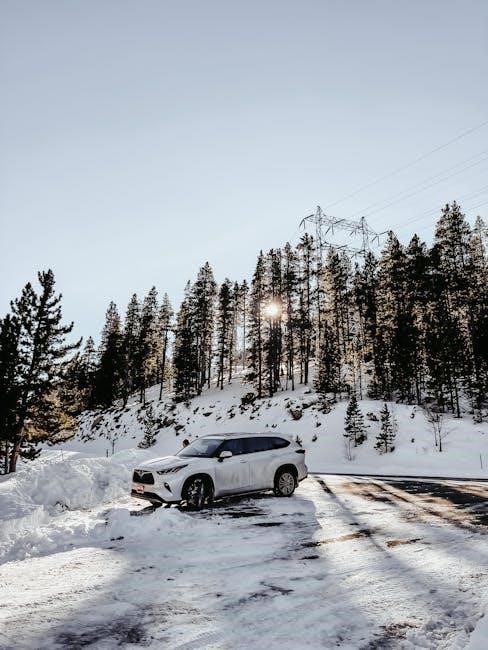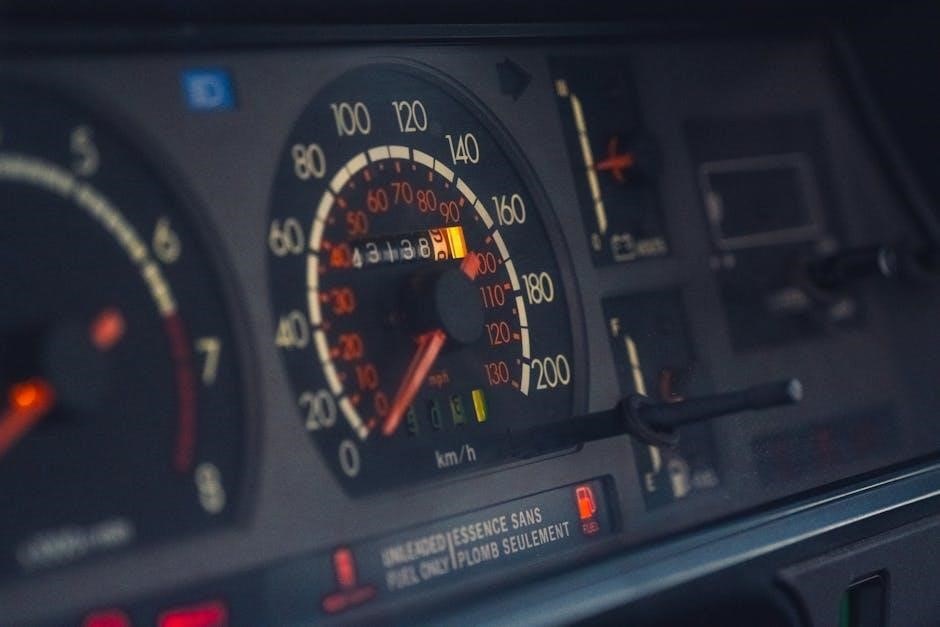keurig k40 user manual
Your Keurig K40 user manual is a comprehensive guide to unlocking the full potential of your coffee maker. It provides essential information for safe operation, troubleshooting, and maintenance to ensure optimal performance and longevity.
Overview of the Keurig K40 Coffee Maker
The Keurig K40 Elite Brewer is a compact and user-friendly coffee maker designed for home and office use. It belongs to the K-Cup series, offering convenience and versatility for brewing coffee, tea, and other hot beverages. The K40 features a sleek design with a 40-ounce water reservoir, allowing multiple cups before refilling. It includes a power button, auto-off timer, and indicators for adding water and heating. The brewer supports various K-Cup pods, enabling customization of strength and flavor. Additionally, it can dispense hot water for soups, cocoa, or other recipes. This model is ideal for those seeking a straightforward, efficient coffee-making experience without advanced frills.
Key Features and Benefits
The Keurig K40 Elite Brewer offers a range of features designed to enhance your coffee-making experience. Its compact design and 40-ounce water reservoir make it ideal for small spaces while allowing multiple cups without frequent refills. The brewer features a simple, intuitive interface with a power button and LED indicators for easy operation. The Add Water indicator ensures you never run out mid-brew, while the heating light signals when the machine is ready. Additionally, the K40 supports a variety of K-Cup pods, giving you flexibility in flavor and strength. The manual provides detailed instructions for first-time setup, brewing, and maintenance, ensuring you get the most out of your machine.

Importance of Reading the Manual
Reading the Keurig K40 user manual is essential for safe and effective use of your coffee maker. It provides critical information on setup, operation, and maintenance to ensure optimal performance. The manual outlines safety precautions, such as avoiding hot surfaces and proper electrical usage, to prevent accidents. It also guides you through troubleshooting common issues like the brewer not powering on or not completing a full cup. By following the manual, you can avoid potential damage to the machine and extend its lifespan. Additionally, it explains how to clean and descale the brewer, which is vital for maintaining water quality and flavor. Understanding the warranty details and customer support options ensures you’re prepared for any unforeseen issues. Taking the time to read the manual will enhance your overall experience and help you get the most out of your Keurig K40.

Setting Up Your Keurig K40
Setting up your Keurig K40 involves unpacking, positioning, and priming the brewer for first use. Follow the manual’s step-by-step guide to ensure proper installation and initial setup.
Unpacking and Initial Inspection
Begin by carefully unpacking your Keurig K40 from its box, ensuring all components are included, such as the brewer, power cord, and sample K-Cup pods. Inspect the unit for any visible damage or defects. Check for all accessories and ensure the water reservoir is empty. Familiarize yourself with the brewer’s features, such as the 40-ounce water reservoir and the brew size options. Before plugging in, review the safety precautions outlined in the manual, including avoiding hot surfaces and ensuring the cord is placed safely. This initial inspection ensures your brewer is ready for setup and first use, providing a smooth experience.

Positioning the Brewer on Your Countertop
Place your Keurig K40 on a flat, stable countertop, ensuring it is at least 8 inches away from any walls or obstructions for proper airflow. Avoid positioning it near hot surfaces or appliances to prevent overheating. Ensure the surface is clean and dry to avoid any water spots or damage. The brewer should be level to function correctly, so check the countertop for evenness. Do not submerge the brewer in water, and keep it out of reach of children. Proper positioning ensures safe operation and longevity, while maintaining your kitchen’s aesthetic with its compact design.
Priming the Brewer for First Use
Before brewing your first cup, prime the Keurig K40 to ensure proper function. Plug in the brewer and fill the water reservoir with fresh water. Place a large cup under the spout. Press the Power Button to turn it on and let the brewer heat up. Once heated, press and hold the Brew Button without inserting a K-Cup to allow water to flow through the system. Repeat this process 2-3 times to clear any air or debris from the internal tubes. This step ensures your brewer is ready for use and prevents any initial issues. Proper priming guarantees a smooth and clean brewing experience for your first cup and beyond.
First Brew Setup and Instructions
After priming, your Keurig K40 is ready for its first brew. Ensure the water reservoir is filled with fresh, filtered water. Place a large cup under the spout to catch the brewed coffee. Allow the brewer to heat up for 2-3 minutes until the heating light turns off. Lift the handle and insert your chosen K-Cup, ensuring it clicks into place. Lower the handle firmly to secure the K-Cup. Select your desired brew size using the button. Press the Brew Button to start the process. Wait for the cycle to complete and enjoy your first perfectly brewed cup. For best results, refer to the manual for optimal K-Cup selection and customization options. This step ensures a seamless and satisfying first brewing experience.

Understanding the Brewing Process
The Keurig K40 brews coffee by inserting a K-Cup, selecting brew size, and starting the cycle. It heats water, punctures the pod, and extracts the perfect cup.
Selecting the Right K-Cup for Your Brew
Selecting the right K-Cup is essential for a perfect brew. With hundreds of flavors, you can choose from a variety of coffee, tea, or specialty beverages. Ensure the K-Cup is compatible with your Keurig K40 to maintain optimal performance. For coffee lovers, opt for medium to dark roasts for bold flavors or light roasts for a smoother taste. Tea enthusiasts can explore herbal or caffeinated options. Always use officially licensed K-Cups to avoid damage to your brewer. Experiment with different brands and blends to find your favorite. Proper K-Cup selection ensures a consistent, high-quality brewing experience every time.
Brewing Options and Customization
The Keurig K40 offers versatile brewing options to cater to your preferences. Choose from three cup sizes: 6, 8, or 10 ounces, allowing you to customize the strength and volume of your brew. For a bolder flavor, select the smaller cup size, while larger sizes provide a milder taste. Additionally, the Keurig K40 features a strength control option, enabling you to adjust the brew’s intensity by pressing the brew button again after selecting your size. This ensures a personalized experience for every cup. You can also use the My K-Cup reusable filter to brew your favorite ground coffee, offering even more flexibility. Experiment with different settings to find your perfect brew every time.
Stopping the Brew Process
To stop the brew process on your Keurig K40, press the Power Button to turn off the machine. The brew cycle will halt immediately, and the Add Water Indicator may flash blue. If the heating light and brew button flash simultaneously, this indicates the process has been interrupted. Note that stopping mid-brew may result in residual water in the K-Cup being drained into the drip tray. Always unplug the brewer after stopping to ensure safety. For more details, refer to the troubleshooting section in your manual. This feature allows you to regain control if you change your mind or notice an issue during brewing.
Purging the Brewer
Purging your Keurig K40 is essential for maintaining its performance and hygiene. Start by ensuring the water reservoir is filled with fresh water. Next, place a large cup under the spout. Press and hold the Brew Button without inserting a K-Cup. The machine will dispense hot water, flushing out any residual coffee oils or debris. Repeat this process 2-3 times to thoroughly clean the internal system. For deeper cleaning, use a Keurig cleaning solution or vinegar by running it through the machine as described in the manual. Regular purging prevents mineral buildup and ensures your coffee tastes its best every time. This simple step helps maintain your brewer’s efficiency and longevity.

Controls and Indicators on the Keurig K40
The Keurig K40 features a Power Button, Brew Button, and indicators like the Add Water light and Heating light to guide seamless operation and maintenance.
Power Button and Basic Operation
The Power Button is the primary control for turning the Keurig K40 on and off. Pressing it once activates the brewer, initiating the start-up process. The Power Button also serves as a key control for basic operation, allowing users to begin the brewing cycle. When pressed, the machine initializes, and the Add Water Indicator and Heating Light will illuminate if necessary. Proper use of the Power Button ensures safe and efficient operation. Always press the Power Button to turn off the brewer before unplugging or performing maintenance. This essential feature simplifies daily use and ensures your Keurig K40 functions optimally.
Auto-Off Timer and Programming
The Keurig K40 features an Auto-Off Timer that automatically turns off the brewer after a period of inactivity, helping to conserve energy. To program the timer, press and hold the Power Button until the Auto-Off light begins to flash. Use the Brew Button to adjust the timer setting, which can be set between 1 and 4 hours. The default setting is 2 hours. Once programmed, the brewer will shut off after the selected time, ensuring efficient energy use. This feature is especially convenient for busy households, as it eliminates the need to manually turn off the machine. Proper use of the Auto-Off Timer enhances the overall efficiency and longevity of your Keurig K40.
Understanding the Add Water Indicator
The Add Water Indicator on your Keurig K40 is a convenient feature designed to notify you when the water reservoir is low. Located on the front of the brewer, the indicator flashes blue when the water level is insufficient to complete a brew cycle. To refill, simply remove the reservoir, fill it with fresh water, and replace it. Ensure the reservoir is securely locked into place to reset the indicator. Proper attention to this feature prevents disruptions during brewing and maintains optimal performance. Regularly checking and refilling the water reservoir helps extend the lifespan of your Keurig K40 and ensures consistent brewing results.
Heating Light and Brew Button Functions
The Heating Light on your Keurig K40 indicates when the brewer is preheating water for a cycle. It illuminates red while heating and turns off once the water reaches the optimal temperature. The Brew Button, located below the Power Button, is used to start the brewing process. When pressed, it triggers the machine to puncture the K-Cup and dispense hot water into your cup. The Brew Button will flash if the machine is not ready or if there is an issue, such as no K-Cup inserted. Proper use of these functions ensures smooth operation and a perfect cup of coffee every time. Always refer to the manual for detailed instructions.

Maintenance and Cleaning
Regular cleaning is essential to maintain your Keurig K40’s performance. Clean the water reservoir and exterior daily, and check for scale buildup to ensure optimal brewing and prevent issues.
Regular Cleaning and Sanitizing
Regular cleaning and sanitizing are crucial for maintaining your Keurig K40’s performance and hygiene. Daily, wipe the exterior with a damp cloth and clean the drip tray. Every week, descale the machine to remove mineral buildup, ensuring optimal water flow and flavor. Additionally, sanitize the water reservoir by rinsing it with fresh water and allowing it to dry. For deeper cleaning, run a vinegar solution through the brew cycle without a K-Cup to eliminate any internal residue. This routine will keep your brewer functioning smoothly and your coffee tasting its best.
Descaling the Brewer
Descaling your Keurig K40 is essential to remove mineral deposits that can affect performance and water quality. Use a Keurig-approved descaling solution or white vinegar. Start by filling the water reservoir with the descaling agent, then run brew cycles without a K-Cup until empty. Repeat with fresh water to rinse thoroughly. This process ensures optimal brewing and prevents clogs. Regular descaling every 3-6 months maintains efficiency and longevity, keeping your coffee tasting great and your machine functioning smoothly. Always refer to the manual for specific instructions to ensure proper maintenance and avoid damage to your brewer.
Proper Storage and Care
Proper storage and care ensure your Keurig K40 performs optimally and lasts longer. Always unplug the brewer when not in use and avoid leaving the cord hanging over edges or near hot surfaces. Store the brewer on a stable, flat surface away from direct sunlight and moisture. Clean the exterior regularly with a damp cloth and avoid using abrasive cleaners. After each use, ensure the water reservoir is empty and dry to prevent mineral buildup. For extended storage, descale the brewer first and store it in a cool, dry place. Proper care and storage maintain the brewer’s efficiency and ensure consistent performance over time.
Water Reservoir Maintenance
Regular maintenance of the water reservoir is crucial for optimal performance and hygiene. Always use fresh, filtered water to prevent mineral buildup. Avoid adding any other liquids or foods to the reservoir, as this can cause damage or contamination; Clean the reservoir weekly by rinsing it with warm water and mild soap. Dry thoroughly to prevent bacterial growth. If the reservoir is detachable, store it in a cool, dry place when not in use. Replace the water regularly to ensure freshness and prevent stagnation. Proper care of the water reservoir helps maintain the quality of your brewed beverages and extends the lifespan of your Keurig K40.

Troubleshooting Common Issues
Troubleshooting common issues with your Keurig K40? This section helps resolve problems like the brewer not turning on or not brewing a full cup. Refer to the manual for detailed solutions.
Brewer Does Not Power On
If your Keurig K40 brewer does not power on, check the power cord connection and ensure it is properly plugged into a working electrical outlet. Verify that the circuit breaker or fuse has not tripped. Press the Power Button firmly to ensure it is activated. If the issue persists, unplug the brewer, wait 30 seconds, and plug it back in to reset the system. If the brewer still does not turn on, contact Keurig Customer Service for further assistance, as there may be an internal electrical issue. Always refer to the manual for detailed troubleshooting steps.
Brewer Will Not Brew a Full Cup
If your Keurig K40 does not brew a full cup, check the water reservoir to ensure it is filled to the recommended level. Scale buildup or mineral deposits may clog the water flow, requiring descaling. Clean the needle by lifting and lowering the brew head to ensure proper alignment and flow. Verify that the K-Cup is correctly inserted and pierced. If issues persist, run a cleaning cycle or purge the brewer by dispensing hot water without a K-Cup. For unresolved problems, contact Keurig Customer Service for support, as this may indicate a malfunction covered under the one-year warranty.
Brewer Shuts Off Automatically
If your Keurig K40 brewer shuts off automatically, this could be due to the Auto-Off feature, which helps conserve energy. Check if the feature is enabled and adjust the timer settings to delay shutdown. Ensure the brewer is on a stable surface and not exposed to direct sunlight or heat sources. If the brewer overheats, it may shut down; allow it to cool before restarting. Verify the power cord is securely connected and functional. If the issue persists, reset the brewer by unplugging it for 30 seconds and plugging it back in. Contact Keurig Customer Service if the problem continues, as it may indicate a technical issue covered under warranty.
Flashing Lights and Error Indicators
Flashing lights on your Keurig K40 indicate specific issues that need attention. The blue Add Water light flashing signals low water levels in the reservoir. If the red Heating light flashes, it may indicate a high temperature or scaling issue. All lights flashing simultaneously could point to a system error. To resolve these issues, first ensure the water reservoir is filled and properly aligned. For persistent errors, unplug the brewer for 30 seconds to reset it. If the Heating light issue continues, descale the brewer as instructed in the manual. Contact Keurig Customer Service if problems persist, as these indicators may signal a need for professional assistance or warranty repair.

Warranty and Customer Support
Your Keurig K40 is backed by a limited one-year warranty covering defects in materials or workmanship under normal home use. For assistance, contact Keurig Customer Service at 1.866.901.BREW (2739). Ensure to register your product and retain your purchase receipt for warranty validation.
Limited One-Year Warranty Details
The Keurig K40 is covered by a limited one-year warranty, ensuring protection against defects in materials or workmanship under normal home use. This warranty is valid from the date of purchase and requires proper registration. To maintain warranty coverage, users must retain their purchase receipt and complete the warranty card provided with the brewer. The warranty does not cover damage caused by misuse, neglect, or unauthorized modifications. For warranty claims or inquiries, contact Keurig Customer Service at 1.866.901.BREW (2739). Representatives are available to assist with repairs, replacements, or general questions about your brewer. Prompt service ensures minimal disruption to your coffee-making experience.
Contacting Keurig Customer Service
For assistance with your Keurig K40, contact customer service at 1.866.901.BREW (2739). Representatives are available to address inquiries, troubleshoot issues, or provide repair and replacement options under warranty. You can also visit the official Keurig website for live chat, email support, or online support forms. Additionally, the website offers a wealth of resources, including FAQs and downloadable manuals. For faster service, have your brewer’s model number and purchase date ready. Keurig’s customer service team is committed to resolving issues promptly, ensuring minimal disruption to your coffee-making experience. Their support is available during extended hours to accommodate your needs.

Additional Resources
For additional support, download the PDF manual, explore online guides, or visit community forums for troubleshooting and tips. These resources ensure optimal use of your Keurig K40.
Downloading the PDF Manual
The Keurig K40 user manual is available for free download as a PDF document, providing easy access to detailed instructions and guidelines. This manual includes setup, brewing, maintenance, and troubleshooting steps, ensuring users can fully utilize their coffee maker. You can find the PDF on trusted websites like ManualsLib or Zofti, with clear download links. The document is in English and contains 16 pages of comprehensive information. It covers essential topics such as priming the brewer, programming the auto-off timer, and descaling. Additionally, the manual includes safety precautions and warranty details. Users can print the PDF for convenient reference or save it digitally for future use. Downloading the manual ensures you have all the necessary guidance to maintain and enjoy your Keurig K40 coffee maker.
Online User Guides and Tutorials
Hundreds of online user guides and tutorials are available to help you master your Keurig K40. Websites like ManualsLib and Zofti offer free access to comprehensive PDF manuals, while YouTube channels provide video tutorials for setup and troubleshooting. Interactive guides on Keurig’s official website walk you through maintenance tasks like descaling and cleaning. Forums and communities share tips and solutions from experienced users, covering common issues like brewer shutdowns and water indicators. These resources ensure you can resolve issues quickly and make the most of your coffee maker.
Community Support and Forums
Engaging with Keurig K40 community support and forums connects you with a network of users and experts. Platforms like Reddit’s r/Keurig and dedicated coffee enthusiast groups share tips, troubleshooting solutions, and personal experiences. Users often discuss common issues, such as brewer shutdowns or water indicator problems, and offer creative fixes. Forums also provide space to ask questions and receive tailored advice from experienced owners. Additionally, Keurig’s official forums and social media pages host discussions on maintenance, optimal usage, and accessory recommendations. These communities are invaluable for resolving issues quickly and discovering new ways to enhance your brewing experience with the K40.










